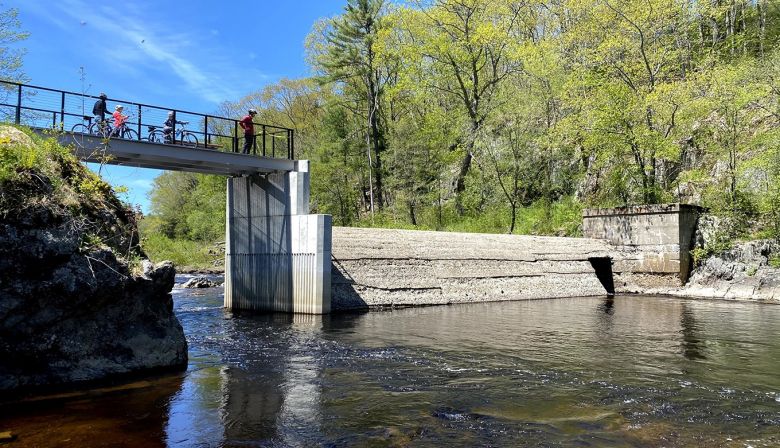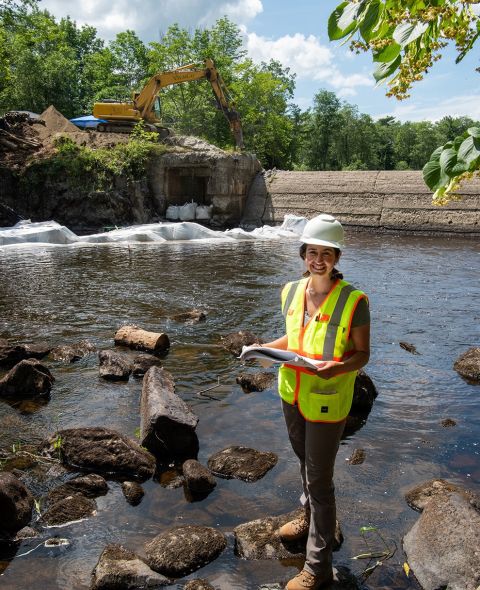“The Sheepscot River is famed for paddling, fishing, and birdwatching,” Nemeth said. “We worked closely with the immediate community to ensure the project achieved on-the-ground results that benefit people and will be an asset for decades to come.”
The project is part of a broader ASF-led Sheepscot River effort that also includes the full removal, in 2018, of Coopers Mills Dam in Whitefield and the establishment of a park at the site; new fishway construction in 2021 at Branch Pond Mill Dam; and additional fish passage projects.
Benefiting from lessons learned in Rhode Island
Sometimes, a river story is still mostly about the fish.
That is the case about 230 miles south of Alna, on the Annaquatucket River in North Kingstown, Rhode Island, where another key project was completed in FY20.
In the 1960s, the four dams along the Annaquatucket — historically the site of one of Rhode Island’s top river herring runs — were outfitted with fishways to allow fish upstream. Unfortunately, over time, changes in the streambed below two of the sites so negatively impacted fish passage that the runs disappeared.
The fishway at Belleville Pond dam in North Kingstown was one of those two sites, and in the latter part of last decade, the Service’s Fish Passage Engineering Team, through a contract with The Nature Conservancy, developed engineering design plans to mitigate the issue.
an excavator digs through a water filled hole as a worker stands near
A SumCo Eco-Contracting crew creates resting pools as part of the Belleville Pond Dam fishway improvement in North Kingstown, Rhode Island. Photo TNC
In fall 2020, TNC and the Rhode Island Department of Environmental Management (DEM) executed the plans, in part by excavating a portion of the river bottom and installing two rock weirs downstream of the ladder to create fish-friendly resting pools with a minimum depth of three feet.
“In the late 60s and early 70s, there was a push to build fish ladders, but without the benefit of custom designs,” said John O’Brien, The Nature Conservancy in Rhode Island’s policy and partnership specialist. “Those limitations — compounded by naturally occurring changes in the streams over time — mean that many older fishways are underperforming or no longer passing fish.”
“With the Fish Passage Engineering Group and (Service fish passage engineer) Bryan Sojkowski, we not only have the tools but also an understanding of herring we couldn’t dream of 50 years ago,” O’Brien said.
The Belleville Pond project followed successful work by TNC and DEM in 2019 to remove another barrier downstream on the Annaquatucket.
Come spring 2021, migratory fish on the river will begin to see the additional benefits.
a mad in waders stands in water while holding a white instrament.
Service fish passage engineer Bryan Sojkowski at Belleville Pond Dam. Photo TNC
Building a new Whiteoak Canyon Bridge: a model for success
Further south, a project at the Whiteoak Canyon Trailhead in Shenandoah National Park in Virginia shines a spotlight on another way river connectivity projects can yield co-benefits for people and nature.
Whiteoak Canyon has long been one of the most popular access points for Shenandoah National Park. But for years, a low-water crossing with undersized culvert pipes on Cedar Run, a tributary of the Robinson River, had been subject to flooding that limited public access, while also acting as a partial barrier to fish seeking the additional cold-water habitat upstream.
Late in 2019, the Piedmont Environmental Council, Trout Unlimited, and other partners removed the old structure and replaced it with a 35-foot high-water bridge that now provides safe and reliable public and emergency vehicle access to trails, in addition to fish and eel access to 3.5 miles of pristine steam habitat.
a ground level view shows water pooling and eroding earth along the road
Before its removal, the low-water crossing on Cedar Run in Rappahannock County, Virginia. Photo Hugh Kenny/Piedmont Environmental Council
a metal bridge spans a low area along a road through the woods
After the project’s completion, the high-water bridge on Cedar Run. Photo Hugh Kenny/Piedmont Environmental Council
The Service’s Virginia Fish and Wildlife Conservation Office provided technical assistance and funding through the National Fish Passage Program for the project. The project is one of several — including another culvert replacement on the Robinson River — completed to improve aquatic connectivity and water quality in headwater streams bordering Shenandoah National Park.
It’s also an example of the type of project the Service is anxious to support throughout the North Atlantic-Appalachian Region — as the cumulative tally of 757 river barriers removed since 2009 with the Service’s help continues to grow.
“Depending on their locations, structures similar to Whiteoak Canyon low-water bridge can constitute public-safety risks in addition to being ecologically detrimental,” Service regional fish passage coordinator Bozek said.
“Removing dams and upgrading road-stream crossings can provide significant benefits for nature and people,” she added. “And that’s a long-term return on investment that’s worthy of precious public resources.”
Conserving the Nature of the Northeast
We conserve nature in the northeast U.S.

